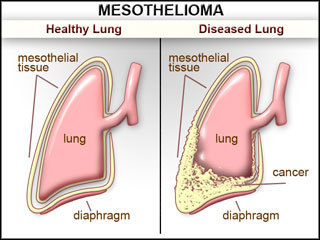Family members and others living with asbestos workers have an increased risk of developing mesothelioma, and possibly other asbestos-related diseases. This risk may be the result of exposure to asbestos dust brought home on the clothing and hair of asbestos workers via washing a worker's clothes or coming into contact with asbestos-contaminated work clothing. To reduce the chance of exposing family members to asbestos fibres, asbestos workers are usually required to shower and change their clothing before leaving the workplace.

See your doctor if you have signs and symptoms that may indicate mesothelioma. Signs and symptoms of mesothelioma aren't specific to this disease and, due to the rarity of mesothelioma, are more likely to be related to other conditions. If any persistent signs and symptoms seem unusual or bothersome, ask your doctor to evaluate them. Tell your doctor if you've been exposed to asbestos.

Patients and their families worry about what to expect after a mesothelioma diagnosis.Your doctor will review all the treatment options with you, which may include surgery, chemotherapy, and radiation.You may also be able to participate in clinical trials.The treatment you receive will be aimed at extending your life, alleviating mesothelioma symptoms and slowing the spread of the cancer if possible.As soon as you are diagnosed with mesothelioma, it is crucial that you see a doctor who specializes in this rare type of cancer.You should also talk to an experienced mesothelioma lawyer about your options for pursuing financial compensation.Contact us today to be connected to medical experts and legal professionals.
Analysis of the interactions between asbestos fibers and DNA has shown that phagocytosed fibers are able to make contact with chromosomes, often adhering to the chromatin fibers or becoming entangled within the chromosome. This contact between the asbestos fiber and the chromosomes or structural proteins of the spindle apparatus can induce complex abnormalities. The most common abnormality is monosomy of chromosome 22. Other frequent abnormalities include structural rearrangement of 1p, 3p, 9p and 6q chromosome arms.
Geological studies show the asbestos in Nevada is much like the asbestos found in Libby, Montana, and an asbestos deposit runs from Nevada to Arizona. Officials in Nevada responded by taking measures to protect workers on projects that involve areas contaminated with asbestos.
Although there are no mesothelioma screening tests yet, if you know or suspect that you have been exposed to asbestos, you should talk to your doctor about doing a chest X-ray once a year.X-rays, CT scans, and MRIs can be used to help diagnose mesothelioma and other asbestos-related diseases early.Also, cutting-edge blood tests (such as the MESOMARK blood test) have the potential to improve your chances of early detection.
Two years later, the IARC presented an update on the link between asbestos and cancer at a World Health Organization conference in Spain. IARC explained the scientific evidence of this link has strengthened over time, and there is overwhelming proof asbestos is carcinogenic to humans, regardless of the type or fiber length.
Why is malignant pleural mesothelioma the most common type of mesothelioma?Most people are exposed to asbestos when fibers from asbestos-containing materials become airborne. This could happen when cutting, sanding, drilling, filing, or otherwise disturbing these dangerous materials. In the past, some workers also were exposed to raw asbestos, which was mixed with other materials to form products such as asbestos cement.Airborne asbestos fibers could easily drift across an entire worksite, putting everyone in the vicinity at risk, not just those who were working directly with the material. This widespread exposure risk makes pleural mesothelioma the most common type of the disease.
In rare cases, mesothelioma has also been associated with irradiation of the chest or abdomen, intrapleural thorium dioxide (thorotrast) as a contrast medium, and inhalation of other fibrous silicates, such as erionite or talc. Some studies suggest that simian virus 40 (SV40) may act as a cofactor in the development of mesothelioma. This has been confirmed in animal studies, but studies in humans are inconclusive.
Pericardial mesothelioma is not well characterized, but observed cases have included cardiac symptoms, specifically constrictive pericarditis, heart failure, pulmonary embolism, and cardiac tamponade. They have also included nonspecific symptoms, including substernal chest pain, orthopnea (shortness of breath when lying flat), and cough. These symptoms are caused by the tumor encasing or infiltrating the heart.
Asbestos is banned in some countries but not in others. By law you now cannot use, reuse, sell or supply materials containing asbestos in Ireland. Even so, there are many materials that still contain asbestos in Ireland.
What Are Mesothelioma Symptoms and Signs? Share Your Story Symptoms of mesothelioma may not appear until 30 to 50 years after exposure to asbestos. The onset of symptoms is gradual, and a person often experiences symptoms for four to six months before the diagnosis is made.You should see a health-care provider if you have any of the following symptoms:Difficulty in breathing (dyspnea) is the most common complaintChest discomfortChest painCoughEasy fatigabilityFeverWeight lossThe above listed symptoms may be caused by mesothelioma or by other, less serious diseases. Only a health-care provider can make a diagnosis with the help of various exams and tests.
The mesothelium is the membrane that surrounds many of the body’s vital organs. This membrane secretes a lubricating fluid that provides easy movement of the organs within the body.This is where the cancer develops when asbestos is inhaled or ingested. When the mesothelium becomes cancerous, it is called mesothelioma.There can be multiple forms of the cancer when it affects the mesothelium.The form is determined by the location in which the tumor begins, known as its origin site, and the type of cells that the tumor invades, known as its histological subtype. Each type may require a different treatment.
Pleurisy, an inflammation of the lining around the lungs, is associated with sharp chest pain upon breathing in. Cough, chest tenderness, and shortness of breath are other symptoms associated with pleurisy. Pleurisy pain can be managed with pain medication and by external splinting of the chest wall.